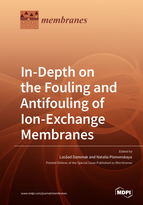In-Depth on the Fouling and Antifouling of Ion-Exchange Membranes
A special issue of Membranes (ISSN 2077-0375). This special issue belongs to the section "Membrane Analysis and Characterization".
Deadline for manuscript submissions: closed (15 June 2020) | Viewed by 32628
Special Issue Editors
Interests: ion-exchange membrane; dialysis; electrodialysis; membrane characterization; fouling; scaling; antifouling strategies; microstructure modeling; water treatment
Special Issues, Collections and Topics in MDPI journals
Interests: ion exchange membranes (monopoler, bipoler) and processes (electrodialysis, dialisis, etc.); transport phenomena in systems with ion exchange membranes (IEMs); concentration polarization, limiting current, coupled phenomena of concentration polarization (water splitting, electroconvection, gravitation convection, etc.); chemical reactions coupled with ions transfer in ampholyte (phosphates, ammonium, aminoacids, proteins, etc.) contaning IEM systems; IEMs fouling; IEM modification; IEM characterization (specific electrical conductivity, diffusion permeability, perselectivity, transport numbers, structure–properties relationship, current–voltage characteristics, chronopotentiommetry, electrochemical impedance spectroscopy, mass transfer characteristics, etc.); experimental techniques development for IEM and membrane system investigation
Special Issues, Collections and Topics in MDPI journals
Special Issue Information
Dear Colleagues,
The use of ion-exchange membranes (IEMs) has accelerated over the past two decades in a wide variety of industrial processes (electrodialysis, electro-electrodialysis, electrolysis, dialysis, etc.) for applications related to chemical, pharmaceutical and food industries, energy production, water treatments, etc. Organic and mineral fouling (or scaling) phenomena are two major factors limiting the efficiencies of IEMs processes and performances (reduction of the IEMs selectivity and stability, increase of their electrical resistance, deduction of the energy efficiency of the process, etc.) leading to significant economic losses. The current washing, cleaning and sterilization processes (anti-fouling treatments) make it possible to recover some of the IEMs performances, but frequently induce degradation on the membrane material.
In this Special Issue, authors are invited to submit original articles and reviews on the subject of fouling and anti-fouling of ion-exchange membranes. The contributions may concern (i) characterization of the used IEMs, (ii) extraction and identification of the fouling and scaling materials both on the surface and in the membrane, (iii) development of fouling and scaling mechanisms, (iv) proposition of new sustainable solutions to improve the anti-fouling properties of IEMs, etc.
Dr. Lasâad Dammak
Prof. Dr. Natalia Pismenskaya
Guest Editors
Manuscript Submission Information
Manuscripts should be submitted online at www.mdpi.com by registering and logging in to this website. Once you are registered, click here to go to the submission form. Manuscripts can be submitted until the deadline. All submissions that pass pre-check are peer-reviewed. Accepted papers will be published continuously in the journal (as soon as accepted) and will be listed together on the special issue website. Research articles, review articles as well as short communications are invited. For planned papers, a title and short abstract (about 100 words) can be sent to the Editorial Office for announcement on this website.
Submitted manuscripts should not have been published previously, nor be under consideration for publication elsewhere (except conference proceedings papers). All manuscripts are thoroughly refereed through a single-blind peer-review process. A guide for authors and other relevant information for submission of manuscripts is available on the Instructions for Authors page. Membranes is an international peer-reviewed open access monthly journal published by MDPI.
Please visit the Instructions for Authors page before submitting a manuscript. The Article Processing Charge (APC) for publication in this open access journal is 2700 CHF (Swiss Francs). Submitted papers should be well formatted and use good English. Authors may use MDPI's English editing service prior to publication or during author revisions.
Keywords
- Ion-exchange membrane
- Fouling and Scaling
- Anti-fouling








